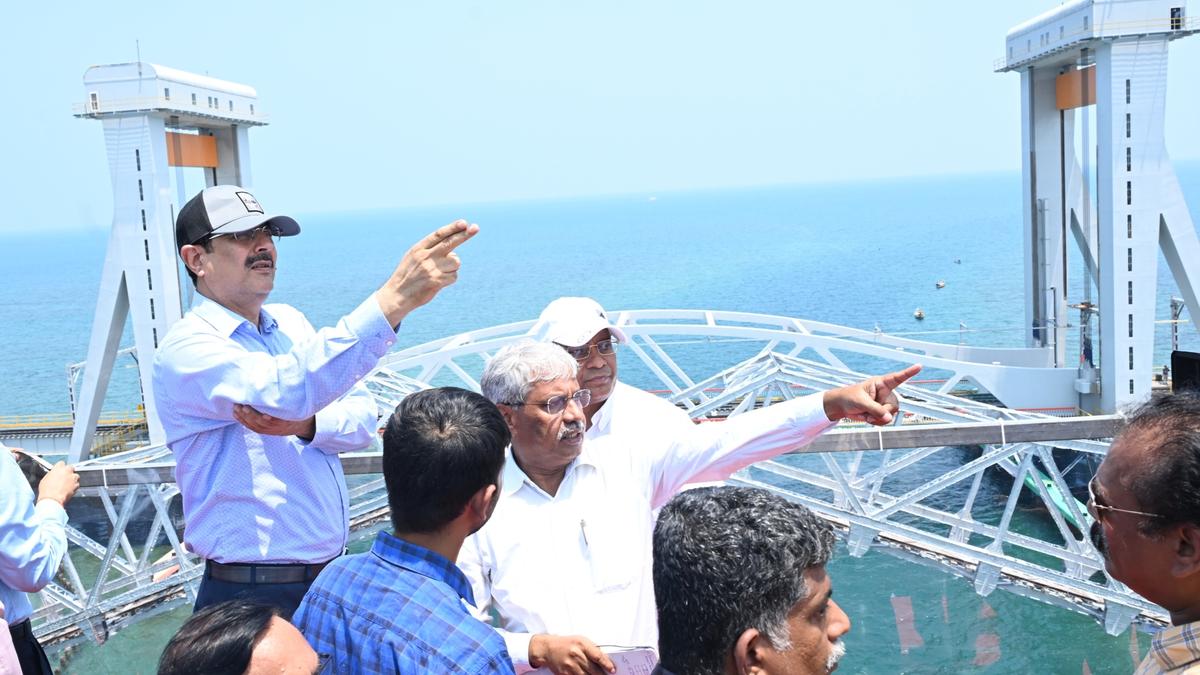New Pamban Rail Bridge

- 30 Mar 2025
In News:
Prime Minister Narendra Modi inaugurated the newly constructed Pamban Rail Bridge on April 6, 2025, coinciding with Ram Navami. The bridge connects Mandapam (mainland Tamil Nadu) to Rameswaram Island, replacing the century-old Pamban bridge.
Key Highlights:
- Total Project Cost: ?531 crore
- Constructed by:Rail Vikas Nigam Limited (RVNL)
- Bridge Type:Vertical-lift railway bridge – thefirst of its kind in India
- Total Length:2.2 km
- Lift Span:72 metres, enabling automated vertical clearance for ships
- Technology: Fully automated lift mechanism (unlike manual operation in the old bridge)
- Materials: Constructed with corrosion-resistant materials for improved longevity
- Sustainability:Solar-compatible design for future energy efficiency
Significance:
- Enhances rail connectivity to Rameswaram, a major religious and tourist destination.
- Improves maritime navigation safety by enabling faster ship movement through the lift span.
- Strengthens coastal infrastructure in Tamil Nadu, supporting economic and strategic interests.
Old Pamban Bridge (1914–2022): A Legacy
- Inaugurated: 1914 by British India (under Madras Railway)
- Length: 2.065 km with 143 piers
- Mechanism:Double-leaf bascule (Scherzer lift) manually operated for ship passage
- Structure Height: 12.5 m above sea level
- Distinction: India’s first sea bridge; remained operational for over 108 years
- Reason for Closure: Severe corrosion led to decommissioning in 2022
Safety and Commissioning Notes:
- The Commissioner of Railway Safety (CRS) conducted a statutory inspection in November 2024.
- CRS had flagged structural and planning lapses; rectification was completed before inauguration.
- Parts of the old bridge will be preserved due to its historical value, though full relocation is not feasible.
Additional Developments:
- New Train Flagged Off: PM Modi flagged a new train service between Tambaram and Rameswaram.
- Rameswaram Station Redevelopment: Work is underway and expected to be completed by September 2025.
Great White Sharks

- 30 Mar 2025
In News:
A 20-year study in South Africa reveals that the decline of Great White Sharks disrupted marine ecosystems, causing cascading food web imbalances.
Key Highlights:
- Scientific Name:Carcharodon carcharias
- IUCN Red List Status:Vulnerable
- Habitat and Distribution:
- Commonly found in temperate coastal waters, including regions off the USA, South Africa, Australia, and Japan.
- Highly migratory, often venturing into tropical waters but returning to temperate zones for feeding.
- Key Biological Features:
- Endothermic Adaptation: Capable of maintaining body temperature higher than surrounding waters (regional endothermy).
- Body Structure: Streamlined, torpedo-shaped body with serrated teeth for efficient hunting.
- Feeding Behavior: Ambush predator – uses a "bite-and-wait" strategy to hunt seals, dolphins, and large fish.
- Reproduction:
- Viviparous: Gives birth to live young.
- Gestation Period: Around 12 months.
- Maturity:
- Females: Mature at 15–16 feet, around 12–18 years of age.
- Males: Mature at 11–13 feet, around 10 years of age.
- Ecological Importance:
- Apex Predator: Plays a crucial role in maintaining the balance of marine ecosystems by regulating populations of prey such as seals and mid-level predators.
- Indicator Species: Their presence signals the health and stability of marine ecosystems.
- Ecological Disruption in South Africa – Key Findings:
- A 20-year study in False Bay, South Africa, revealed a significant decline in Great White Shark numbers.
- This led to:
- A surge in seal populations and sevengill sharks.
- A corresponding collapse in populations of smaller sharks and fish, showcasing a trophic cascade and food web imbalance.
USCIRF’s 2025 Report

- 30 Mar 2025
In News:
In its 2025 Annual Report, the United States Commission on International Religious Freedom (USCIRF) recommended designating India as a "Country of Particular Concern" (CPC), citing alleged systemic violations of religious freedom.
Key USCIRF Recommendations:
- Label India as a CPC under the International Religious Freedom Act (IRFA), 1998.
- Impose targeted sanctions on Indian institutions, including the Research and Analysis Wing (RAW), and individuals such as Vikash Yadav.
- Review bilateral defence agreements, including drone deals.
- Prioritise religious freedom in diplomatic dialogues with India.
- Reintroduce the Transnational Repression Reporting Act, 2024 to monitor global religious freedom violations.
About USCIRF:
- Established by: U.S. Congress (1998) under IRFA.
- Nature: Independent, bipartisan federal agency.
- Not affiliated with: U.S. State Department (but works in coordination).
- Structure: 9 Commissioners appointed by the U.S. President and Congressional leaders.
- Mandate: Monitor global religious freedom (FoRB), advise U.S. leadership, recommend sanctions, and publish annual reports.
Core Functions:
- Track global trends in freedom of religion or belief.
- Recommend policy actions including CPC designation.
- Advocate for religious prisoners of conscience.
- Maintain a FoRB Victims List and issue thematic reports.
India’s Official Response:
The Ministry of External Affairs (MEA) firmly rejected USCIRF’s report, calling it “biased and politically motivated.”
- MEA Spokesperson Randhir Jaiswal criticized the report for misrepresenting isolated incidents and ignoring India’s multicultural and pluralistic society.
- Highlighted India’s 1.4 billion diverse population, representing all major religions.
- Emphasized that USCIRF’s assessments reflect a deliberate narrative rather than genuine concern for religious rights.
- Asserted that such reports would not affect India’s image as a democratic and tolerant nation.
- Called for USCIRF itself to be recognized as an “entity of concern.”
Vertically-Launched Short-Range Surface-to-Air Missile (VL-SRSAM)
- 30 Mar 2025
In News:
India successfully conducted a flight test of the VL-SRSAM from a defence testing range off the Odisha coast.
Overview:
- Type: Indigenous short-range surface-to-air missile (SRSAM)
- Developed by: Defence Research and Development Organisation (DRDO)
- Purpose: Designed for quick reaction air defence, capable of intercepting a variety of aerial threats including low-altitude sea-skimming targets.
- Users:Originally developed for the Indian Navy, with applications now extending to the Indian Air Force for safeguarding air bases.
Performance Parameters:
- Initial range: 40 km (Navy version)
- Extended range: Up to 80 km
- Maximum altitude: 16 km
- Top speed: Mach 4.5
Technical Specifications:
- Length: 3.93 meters
- Diameter: 178 mm
- Wingspan: 508 mm
- Weight: ~170 kg
- Propulsion: Solid fuel
- Guidance System:
- Mid-course: Inertial navigation based on fibre-optic gyroscope
- Terminal phase: Active radar homing
- Launcher Configuration: Twin quad-pack canisters integrated with weapon control systems (WCS) for multiple missile launches.
Significance:
- Enhances India's self-reliant air defence capability.
- Supports indigenous development under the Aatmanirbhar Bharat initiative.
- Strengthens India's maritime and aerial defensive posture through versatile deployment.
Baalpan ki Kavita Initiative

- 30 Mar 2025
In News:
To fulfil the vision of NEP 2020, the Department of School Education & Literacy (DoSE&L), Ministry of Education has launched “Baalpan ki Kavita initiative: Restoring Bhartiya rhymes/poems for young children” for preparing a compendium of nursery rhymes/poems in all Bhartiya Bhasha and also in English, focusing on content relevant to the Indian context.
Key Highlights:
Objective:To compile a national-level compendium of nursery rhymes and poems in all Bhartiya Bhashas (Indian languages) and English, with a focus on culturally relevant content for early childhood learning.
Key Features:
- Encourages multilingual and mother-tongue based education, in line with National Education Policy (NEP) 2020.
- Aims to make foundational learning joyful, relatable, and rooted in Indian ethos.
- Invites existing folklore rhymes and newly composed poems across three age-based categories:
- Pre-primary: Ages 3–6
- Grade 1: Ages 6–7
- Grade 2: Ages 7–8
- Open to submissions in all Indian languages and English.
Significance:
- Reinforces foundational literacy through culturally contextual content.
- Promotes regional literature, creativity, and early multilingualism.
- Strengthens identity and connection to Indian culture from an early age.
Baalpan ki Kavita Initiative

- 30 Mar 2025
In News:
To fulfil the vision of NEP 2020, the Department of School Education & Literacy (DoSE&L), Ministry of Education has launched “Baalpan ki Kavita initiative: Restoring Bhartiya rhymes/poems for young children” for preparing a compendium of nursery rhymes/poems in all Bhartiya Bhasha and also in English, focusing on content relevant to the Indian context.
Key Highlights:
Objective:To compile a national-level compendium of nursery rhymes and poems in all Bhartiya Bhashas (Indian languages) and English, with a focus on culturally relevant content for early childhood learning.
Key Features:
- Encourages multilingual and mother-tongue based education, in line with National Education Policy (NEP) 2020.
- Aims to make foundational learning joyful, relatable, and rooted in Indian ethos.
- Invites existing folklore rhymes and newly composed poems across three age-based categories:
- Pre-primary: Ages 3–6
- Grade 1: Ages 6–7
- Grade 2: Ages 7–8
- Open to submissions in all Indian languages and English.
Significance:
- Reinforces foundational literacy through culturally contextual content.
- Promotes regional literature, creativity, and early multilingualism.
- Strengthens identity and connection to Indian culture from an early age.
